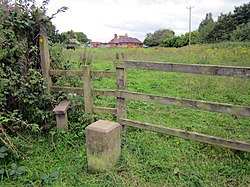History
The camp was created between 1938 and 1939 for use as a military training camp during the Second World War. It was established as a basic training facility for light anti-aircraft batteries and subsequently became the primary training centre for the 233 Light Anti-Aircraft Training Regiment of the Royal Artillery. In 1949, it became Training Centre No. 12 of the Royal Pioneer Corps, and in the 1950s and early 1960s it became a training centre for the Royal Corps of Signals. [1] The King's Own Royal Border Regiment were based at the site from 1973 to 1974, [2] the Green Howards were based there from 1974 to 1976, [3] the Queen's Lancashire Regiment were based there from 1976 to 1978 [4] and the Gordon Highlanders were based there from 1978 to 1980. [5] The King's Regiment were billeted at the camp until its closure in 1985, when the regiment moved to the Dale Camp, Chester's last remaining military barracks. [6]
In the early 1980s Saighton became a training centre for the Royal Army Medical Corps. It remained open after the barracks closed but its use diminished until it was closed completely in 1999. [7]
In 2015, the site was cleared of its remaining military infrastructure. It is now a residential housing estate. [8]
This page is based on this
Wikipedia article Text is available under the
CC BY-SA 4.0 license; additional terms may apply.
Images, videos and audio are available under their respective licenses.

